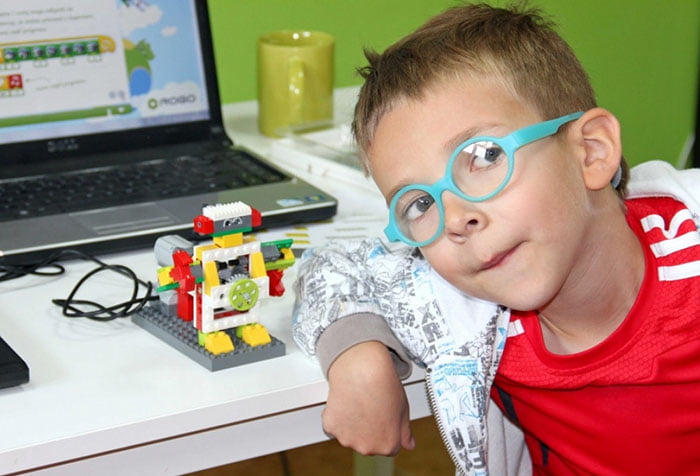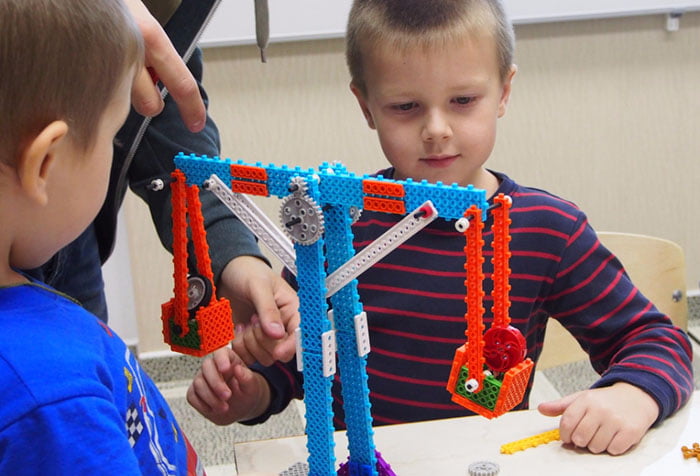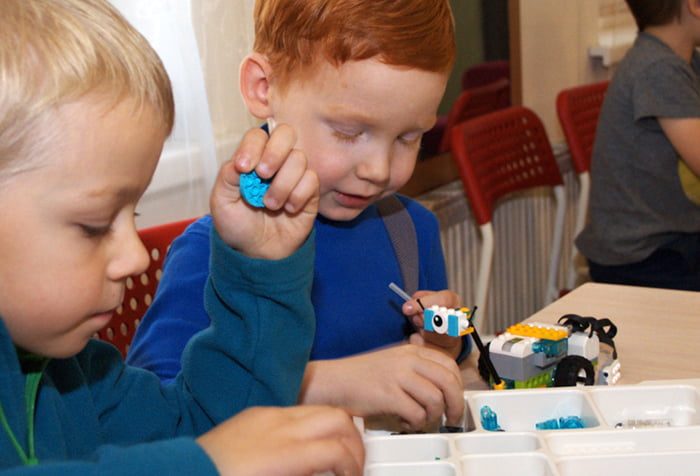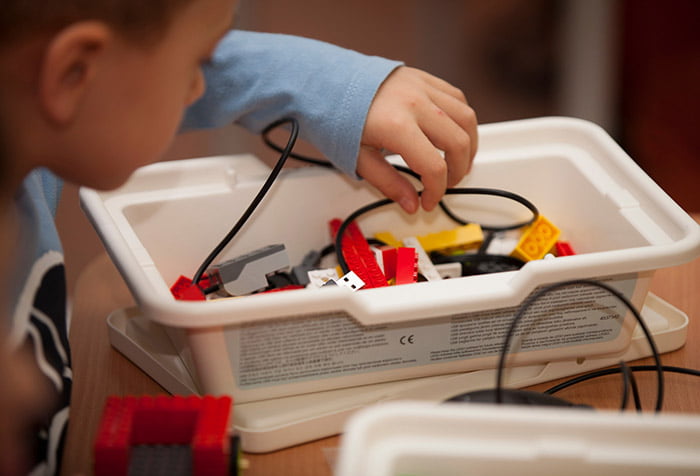Robotics classes for children, their benefits and organization rules
For the development of a modern child, it is necessary to use appropriate techniques that will fully meet the needs of the time. That is why many parents are beginning to wonder what robotics is for preschoolers, is it as effective as the leaders of circles and schools in this area promise, what skills it develops. Note that the direction is not new, but only now it has begun to rapidly gain popularity.
What it is?
Robotics classes are a creative process in which a child manages to create his own product - a robot. You don't have to think that something complex is emerging, some kind of artificial intelligence - no, kids, in fact, work with special constructors, creating figures and machines, using the teacher's hints and their own imagination. The essence of the lesson is to study mechanisms, simplified work with motors, levers, a wheel, create models according to schemes, or even invent your own. Such activities are within the power of children 5-6 years old. Older guys begin to get acquainted with programming - their task becomes more complicated: you need not only to assemble a model, but also to write a simple program for it on a PC. Such developmental exercises provide an opportunity to form an interest in technology in children and acquire essential skills.
The classes themselves help to develop perseverance, purposefulness, the ability to look for alternative ways to solve the problem, and these qualities, in turn, will greatly help both in school and in the later life of the child. That is why the question of robotics classes in kindergartens was raised at the state level - this form of work allows you to form a creative personality, ready to fantasize and translate your ideas into a life endowed with spatial and constructive thinking.

Views
Robotics can be divided into 3 types:
- sports;
- educational;
- creative.
The sports variety is aimed at solving Olympiad problems, helping students who are fond of this area to demonstrate their success. The competitive element is clearly expressed in it, during a certain period a young robotics engineer creates his own product, and then takes part in competitions.
The creative variety is the design of a robot "for oneself", without an orientation towards rivalry, the creation of a product is an end in itself.
Finally, educational robotics - the main object of our attention - is the integration of mathematics, physics, computer science, technology, which allows the formation and development of the most important qualities of a harmonious creative personality in a child. It identifies technical aptitudes in a preschooler at an early stage, which makes it possible to further improve them. In such classes, children will design cars, forklifts, airplanes - everything that they are familiar with in real life. In addition, it will be interesting for preschoolers to create their favorite fairy-tale characters from parts (some manufacturers of educational constructors provide this opportunity).

How to develop the most important areas for a child in 20-30 minutes a day
- Three ready-made scenarios for complex developmental classes in pdf format;
- Video recommendations for conducting complex games and for their independent compilation;
- A flowchart for drawing up such activities at home
Subscribe and get free:
Best age to start
Note that the goal of robotics classes for preschoolers is, first of all, to develop the personality of the baby, his creative and intellectual abilities, and not to create some technically complex unique product. Children at the age of 5 begin to have an interest in mechanisms and construction, which must be used for their productive development.
For the smallest "robotics" it is proposed to use a special type of constructor - with large parts, intuitive mechanisms that are easy to connect with each other. The first success is very important, because it helps the child to gain confidence in their abilities and the desire to continue studying. If the kid wishes, the classes can be continued at school, in this case they will reach a new level and will not only develop general skills and abilities, but also help the child gain specific knowledge.

The benefits of robotics
Conducting modern design classes will no doubt be very beneficial for the preschooler. Robotics fully complies with the spirit of the times, it allows you to prepare your baby for the realities of today's life, where mechanisms and machines play a key role. In addition, the benefits of classes are as follows:
- the child works with small elements, which helps to develop fine motor skills;
- gets the first programming experience;
- improves math skills (counting, symmetry, proportions);
- learns to communicate with peers and teachers, work in a team, quickly navigate in space;
- gets the first skills of presentation of his "creation";
- develops thinking, attention, memory.
Such activities, due to the form of play, are interesting to the child, do not cause boredom in him, so he works with pleasure. Through play, the child learns to think, to focus on solving the problem. Robotics activates his cognitive activity, increases interest in the learning process itself.
How and where to study
Classes in robotics for children are held in kindergarten groups, as well as on a paid basis in special preparatory institutions, where there are qualified personnel working in this particular direction.
The algorithm looks like this:
- Kids receive a set of constructors and a task (for example, to assemble an animal according to the instructions).
- Construction. As a rule, a team of 2-3 guys is working on the creation of one robot.
- Programming. Writing by a child the simplest program that will control a robot on a computer. There is no need to worry that the baby will spend a lot of time in front of the monitor - educational constructors are made in such a way that it will not take more than 10-15 minutes to create a program, and this is the allowed time. This stage is skipped for the smallest "technicians".
- Testing. Children, together with the teacher, check whether they have succeeded in fulfilling the goal - that is, whether the robot performs the actions that are laid down in the program. In the early stages, the stage is removed, replaced by the presentation of your creation.
Do not be alarmed - the algorithm described above includes several activities that will support the kid's interest, because he will certainly want to complete the creation of his own robot and check its performance.
It is best to do robotics in a specially equipped office. It is here that everything necessary for the comfort of the child should be located: the designers themselves, instructions, tables for work, a PC for programming.

Features of the lesson
In order for robotics as a means of developing children's technical creativity to best realize its potential, experts suggest adhering to the following rules for organizing a lesson:
- There are no more than 10-15 children in a group, and it is divided into subgroups. So the teacher will be able to pay attention to everyone and answer the questions that arise.
- Training work is carried out by a teacher who has received the necessary qualifications. This is the main problem of kindergartens - not all cadres have the desire or opportunity to study modern construction sets in order to transfer this knowledge to young pupils later.
- The work is carried out according to a previously drawn up thematic plan.
- It is important for teachers to communicate with the parents of toddlers, this will help organize joint work on the development of the technical and creative abilities of preschoolers.
Robotics classes with children also involve various competitions, exhibitions, presentations of works, where young designers will be able to show what they have managed to do. Such events help the child learn to confidently behave in front of the public.
It is best to do it not at home, but in special institutions, because, firstly, the equipment (the designers themselves) is not cheap, and secondly, not every parent has the necessary knowledge to pass it on to the baby, and, finally, only in a team, under With the guidance of an experienced mentor, you can succeed and learn to communicate.
At home, mom and dad can listen to how the child enthusiastically shares his impressions, see photographs of his work. Parents should also visit the exhibition, which will present the result of the child's labors. All this will be pleasant for the preschooler and will strengthen his desire for further activities.

Necessary equipment
For a successful robotics lesson with kids, you need to have special constructors, the distinctive features of which are:
- large bright details;
- minimum of electronics;
- simple connection mechanisms.
Children at 5 years old do not do programming, but later, at 7-10 years old, working on a PC will also become an activity.
If desired and possible - and, of course, the child's interest - an educational kit can be purchased so that the child is engaged in the construction of the house. Modern manufacturers offer a huge selection of a wide variety of models, designed for different ages and training levels. Some sets represent not only the elements themselves, but also workbooks, instructions, diagrams - everything that will help the preschooler not only have fun, but also learn, get acquainted in a visual form with the laws of physics and the actions of mechanisms.
Popular brands include LEGO Education, Fischertechnik, Huna, Makeblock. The first is considered the most popular and universal, most often it is he who is purchased for classes with preschool children. The advantage of such a constructor is also in the fact that several lines have been developed, each of which is limited to a certain age range. So, there are sets of 5+ and 7+, the most simple and understandable to the crumbs, as well as special rulers for 8-10 years old, making it possible to assemble a real robot. For high school students, their own kits are offered, even more advanced, allowing you to make a programmable robot that can interact with its fellows.
This is robotics - effective activities that will help kids learn to design, develop technical creativity, and improve a number of essential skills. Of course, not every preschooler attending such courses will become an engineer, but everyone will receive useful knowledge and skills necessary for a normal adult life. That is why this direction is more and more actively included in the compulsory kindergarten program, and there are also a huge number of circles that conduct classes on a paid basis.
